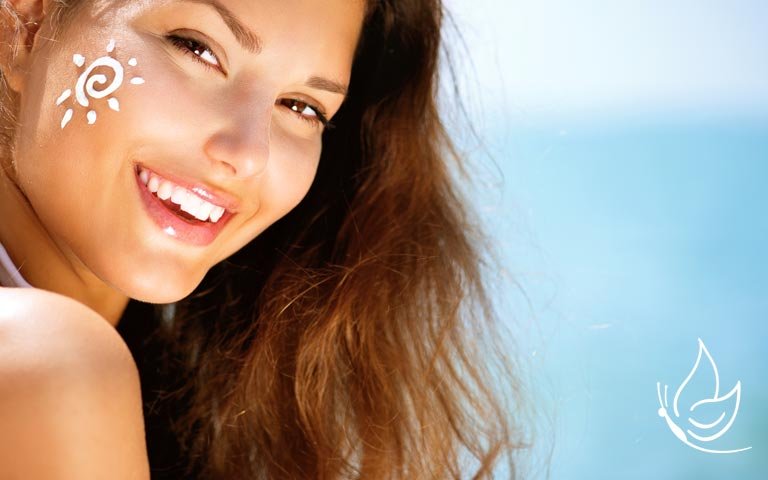What is Broad-Spectrum protection?
This means that the sunscreen must protect you against ultra-violet A and UVB rays.
(UVA = Aging) UVA rays reach the skin deeper and cause your skin to wrinkle and age faster.
(UVB = Burning) UVB rays reach the outer layer of your skin and cause your skin to tan and sunburn.
- Indoor tanning contains UVA and UVB rays.
- Both UV rays work in conjunction and cause severe damage to your skin.
- UVB rays are responsible for the color change of the skin as well as the sunburn.
- UVB rays are responsible for the majority of skin cancers.
- UVA rays are also present on cloudy/rainy days and 80% of those rays penetrate through clouds!
- UVA penetrates the skin more deeply than UVB and does not produce any color change.
- UVA are present with relatively equal intensity during all daylight hours throughout the year!
Did you know that 90% of the skin aging signs are caused by day-to-day UV exposure?
Is there a difference between “waterproof” and “water-resistant?”
How well the sunscreen stays on the skin after swimming, bathing or perspiring is just as important as the SPF level. The FDA considers a product “water-resistant” if it maintains its SPF level after 40 minutes of exposure to water. “Waterproof” products must maintain the SPF level after 80 minutes of water exposure.
Chemical Sunscreen vs. Physical Sunscreen
Physical Sunscreens work by deflecting sun rays away from the skin. Chemical Sunscreens work by scattering and absorbing radiation from sun rays before they can interact with the skin.
How can they affect the skin?
Physical sunscreens: Titanium dioxide can be problematic for some people. (If you break out from mineral makeup and physical sunscreen, titanium dioxide could be the cause.)
Zinc oxide is generally safe. It can be used on delicate skin and is the main ingredient in diaper rash creams.
Chemical sunscreens: Chemical sunscreens tend to be more irritating to the skin.
It can make your eyes sting and water if it gets in your eyes. Some can cause allergic reactions.
When do they start working?
Physical sunscreens: Starts protecting immediately upon application.
Chemical sunscreens: Must wait 20 minutes after application for effective sun protection.
The Rules of SPF Sunscreens:
Wear Sunscreen the right way!
- The order is important.
- Apply it last, after your moisturizer. Before Makeup.
Wait for it to work!
- Chemical sunscreens need 20-30 minutes to form a protective layer.
- Physical sunscreens do not need time, they work immediately.
- Some products combine both so figure at least 20 minutes before sun exposure.
Apply enough sunscreen!
- For your face: ¼ teaspoon for the liquid type, size of a penny for the thick type
- For your body: 2 tablespoons or 1 ounce
Pat or rub?
Pat it all over. Rubbing it may cause skin irritation and might ball up makeup and the products underneath it.
Re-apply!
- If you are going to be outdoors, re-apply it every 2 hours!
- Apply after sweating or swimming!
Remove it before going to bed!
Be sure to wash your skin before going to bed to avoid any skin clogging and irritation!
Use it every day!
- UVA penetrates through glass and causes damage on cloudy or rainy days!
- Remember: 80% of sun’s rays penetrate through clouds!
Apply Sunscreen Everywhere!
Using a sunscreen on your lips keeps your lips feeling and looking healthy and vibrant and protects in two ways. First, lips naturally have thin skin, and sun exposure damages collagen and elastin making lips even thinner and less plump. Second, lacking SPF in your lip products puts you at an increased risk of skin cancer.
Lip gloss without SPF might increase the possibility of developing skin cancer by acting as a kind of magnifying glass for the sun’s rays. Consider using a lip gloss with SPF, or foregoing the lip gloss completely and switching to a matte lip product with SPF. Apply your regular sunscreen over your lips, and layer with your SPF lip balm throughout the day to maintain protection.
Seventy percent of beachgoers used no sun protection for their lips, and among those that did, most people do not know how to apply properly. In most cases, lip sunscreens are not applied thickly or frequently enough. Additionally, lip blocks may be poorly absorbed and can be broken down quickly by UV light, losing their effectiveness — leading to the need for frequent reapplication.
Most common places where people forget to apply sunscreen:
- Around the eyes
- Tip of the nose
- Tops of the feet
- Lips
- Near the hairline
- Scalp
Visit Rejuvent SkinCare and Buy Yours Now!




